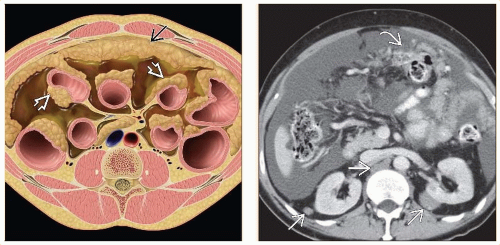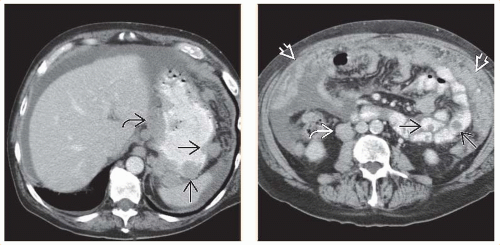Peritoneal Metastases
R. Brooke Jeffrey, MD
Key Facts
Terminology
Peritoneal carcinomatosis, peritoneal implants, omental masses (“caking”)
Metastatic disease to omentum, peritoneal surface, peritoneal ligaments, &/or mesentery
Imaging
Best diagnostic clue: Omental caking, soft tissue implants on peritoneal surface
CT findings
Ascites, nodular peritoneal thickening/enhancement, hypovascular omental caking
Spiculated mesentery
Evidence of bowel obstruction with delineation of transition zone from dilated to nondilated bowel
Best imaging tool: CECT or MR
Protocol advice: Oral & IV contrast (CECT), gadolinium-enhanced GRE or T1 sequence (MR)
Top Differential Diagnoses
TB peritonitis
Papillary serous carcinoma of peritoneum
Peritoneal mesothelioma
Pseudomyxoma peritonei
Pathology
Peritoneal metastases indicate stage IV disease
Clinical Issues
Abdominal distension and pain, weight loss, ± ascites
M < F in secondary ovarian carcinoma
Poor prognosis in general
Diagnostic Checklist
TB peritonitis
TERMINOLOGY
Synonyms
Peritoneal carcinomatosis, peritoneal implants, omental masses (“caking”)
Definitions
Metastatic disease to omentum, peritoneal surface, peritoneal ligaments, &/or mesentery
IMAGING
General Features
Best diagnostic clue
Omental caking, soft tissue implants on peritoneal surface
Cystic peritoneal masses with ovarian carcinoma on peritoneal surfaces
Ascites, mesenteric stranding, bowel obstruction
Location
Peritoneum, mesentery, peritoneal ligaments
Size
Variable; 5 mm nodules to large confluent omental caking
Morphology
Nodular, plaque-like, or large omental mass
Radiographic Findings
Radiography
Plain film findings of significant ascites
Medial displacement of cecum in 90% of patients
Pelvic “dog’s ear” in 90% of patients
Medial displacement of lateral liver edge (Hellmer sign) in 80% of patients
Bulging of flanks, central displacement of bowel loops, indistinct psoas margin

Stay updated, free articles. Join our Telegram channel

Full access? Get Clinical Tree














